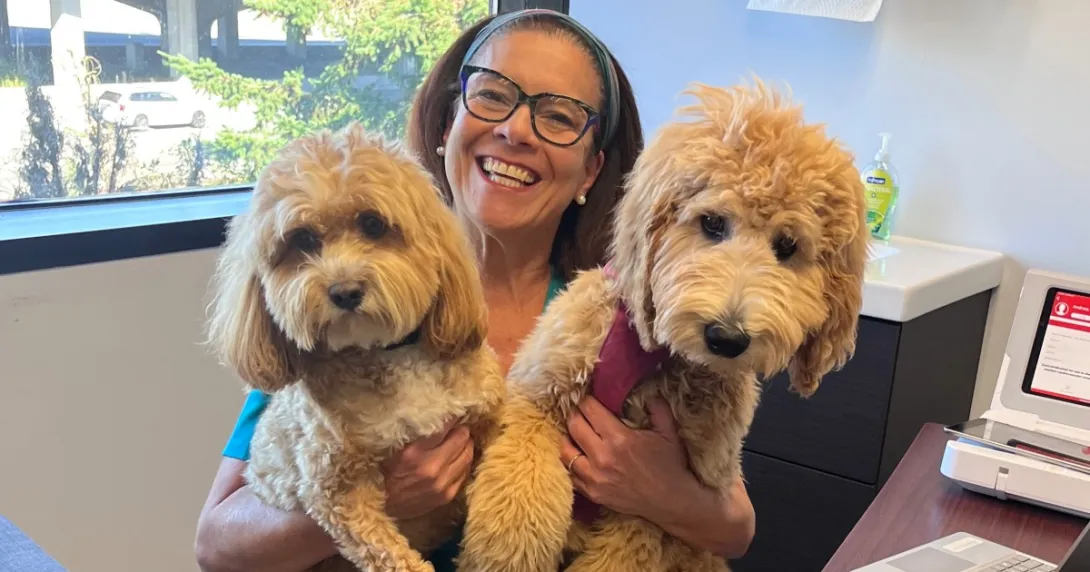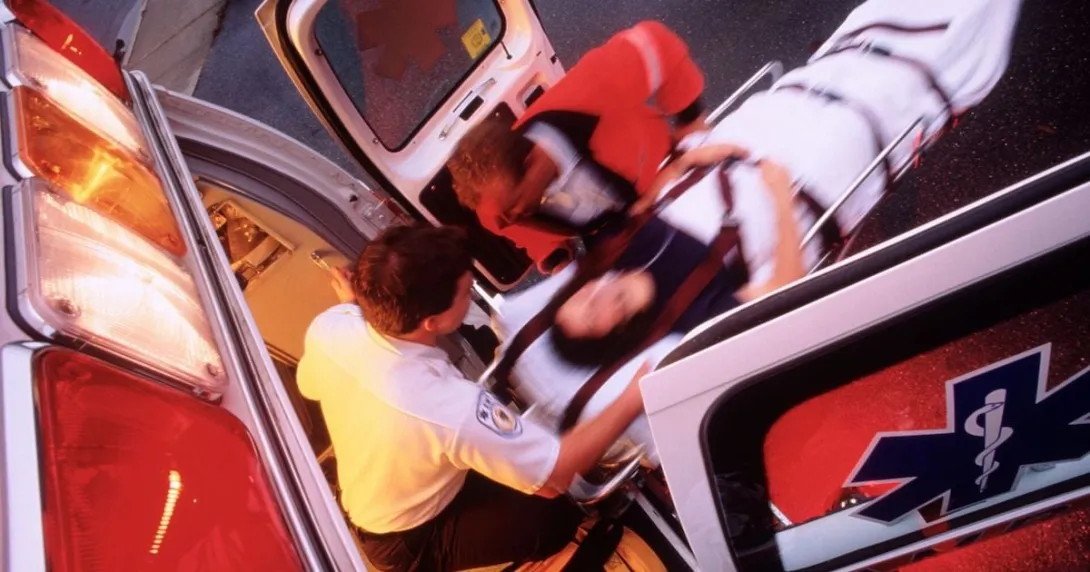
Dr. Viviane Bunin, who runs RheumCenter with the help of Ottis (left) and Winnie (right)
Photo: Dr. Viviane Bunin
RheumCenter is a medical office run by Dr. Viviane Bunin, a physician with a medical degree in rheumatology and a doctorate in immunology.
THE CHALLENGE
The challenge she was facing was not in using her new heart rate variability diagnostic equipment – she describes it as remarkably user-friendly, comparable to running a simple EKG – but in the logistics of patient access.
"Historically, patients with suspected autonomic dysfunction had to wait months for an appointment at a tertiary neurology center, often reserved for only the most severe, life-threatening cases," she explained. "For rheumatology patients struggling with fatigue, dysautonomia or inflammation-linked symptoms, this delay meant lost opportunities to guide therapy.
"My main challenge internally was updating my own knowledge base – reviewing emerging literature on the autonomic nervous system and its links to immune and inflammatory pathways – so I could translate HRV data into actionable conversations with patients," she added.
On the administrative side, there was initial uncertainty about billing and reimbursement with this diagnostic testing via the CloudHRV system from vendor Inmedix: Would prior authorization be required? Could the test be performed on the same day as a visit?
"I piloted both approaches – ordering the test separately versus performing it immediately with a modifier," she noted. "To my surprise, both pathways worked, and reimbursement patterns mirrored other common procedures. This early reassurance allowed me to integrate testing smoothly into my workflow."
PROPOSAL
As one of the first practices to implement the HRV system, she received full support from the vendor's scientific, IT and administrative teams. They walked her through everything from electrode placement to billing code integration.
"I also engaged in scientific discussions and received literature that strengthened my understanding of HRV's clinical implications," she said. "The few technical issues – such as saving results templates and cloud access – were rapidly resolved.
"For example, in the first weeks, some reports were delayed in posting to the cloud, but I could still print the immediate test output and pair it with my own clinical interpretation handout for patients," she explained. "This level of support made the adoption process seamless and confidence-building. The equipment itself is very user-friendly, requiring only minimal ongoing support."
Bunin said the technology's strength lies in its simplicity.
"A patient can have a validated autonomic assessment completed in just five minutes during a routine office visit," she noted. "The alternative – a full dysautonomia evaluation – can take hours of tilt-table testing and is typically scheduled months out.
"By reducing that barrier, CloudHRV allows rheumatology patients to receive same-day insights into their autonomic balance," she continued. "That information is not only useful for initial diagnosis but also for monitoring therapy: tracking steroid tapering, lifestyle interventions or responses to biologic agents. From an implementation standpoint, I simply needed to master troubleshooting, documentation and patient education – then reimbursement followed naturally."
MEETING THE CHALLENGE
In her solo practice, Bunin uses a remote medical assistant, so she personally performs the vital signs. She added body composition and HRV documentation to her routine.
"After the physical exam, while the patient is supine on the exam table, I place electrodes and begin the five-minute recording," she explained. "While the machine captures the data, I use the time to complete charting and orders.
"Patients leave with both their results and a concise handout that explains the meaning of their HRV indices, along with practical steps – such as breathing exercises, physical activity or sleep hygiene – to improve autonomic balance. This workflow makes the test additive, not disruptive, to clinic flow."
Bunin runs RheumCenter as the sole on-site physician, supported remotely by her medical assistant. Her patients are actively engaged in monitoring their symptoms, collecting data from their medical journey and sharing results.
"HRV fits perfectly into a shared decision-making model of care," she explained. "The quantified indices provide patients with a 'number' they can compare over time – just like health assessment questionnaires, disease activity indexes or vital signs. Having this objective measure makes patients feel more comfortable and confident when discussing treatment choices.
"Many patients, who have long sought an explanation for their stress-immune response, now schedule brief visits just to document HRV," she continued. "What makes this powerful is the continuity: I know the patient's story, I collect the data, and I translate the results into individualized therapeutic plans. The patient sees the entire process from start to finish, which enhances trust, engagement and partnership in care."
At present, the HRV system is not integrated with Bunin's electronic health record. Instead, it functions as a standalone diagnostic procedure, with results attached manually to the chart and shared with other providers, much like lab or imaging reports. While auto-population into EHRs will likely come in the near future, the current "report-and-attach" workflow is straightforward and effective for her.
"As the technology evolves, I anticipate patients themselves having personal, cloud-connected HRV devices for ongoing monitoring at home," she predicted.
RESULTS
Between June and August 2025, across 42 in-office workdays, Bunin performed 66 HRV tests. Of these:
- 52 tests (78.8%) were reimbursed by insurers, with payments ranging from $112.94 to $207.02 and an average of $174.73.
- 2 tests (3%) were denied, labeled "experimental procedure."
- 3 tests (4.5%) were patient responsibility due to unmet deductibles.
- 7 tests (10.6%) remain pending as of September 14, 2025, with an average waiting time of 15 days (range 14–17).
Of note, prior authorization was never required – a critical factor for maintaining efficiency in a solo practice.
"Clinically, HRV results have guided multiple aspects of care: adjusting steroid tapering schedules, validating patient experiences of fatigue and dysautonomia, and uncovering autonomic dysfunction in patients otherwise lacking explanations for their symptoms," she reported.
"Patient feedback has been remarkable," she continued. "Many describe the test as validating and motivating, with one saying, 'I'll come just for the test.' This kind of engagement is itself a valuable outcome."
ADVICE FOR OTHERS
Bunin advised her peers to view autonomic testing as the next logical extension of vital signs, disease activity indexes and health assessment questionnaires.
"Just as we once expanded from pulse to blood pressure, we are now moving toward integrating HRV as a routine measure of physiologic resilience," she explained. "Its correlation with disease activity – whether inflammation, pain or therapeutic response – is an area of ongoing data collection and clinical validation.
"The healthcare landscape is increasingly split: Large corporate systems delivering standardized care versus independent practices and empowered patients who actively participate in their health," she continued. "In the latter setting, HRV provides immediate, actionable data that support individualized treatment decisions."
Follow Bill's health IT coverage on LinkedIn: Bill Siwicki
Email him: bsiwicki@himss.org
Healthcare IT News is a HIMSS Media publication.
WATCH NOW: Seattle Children's Chief AI Officer talks better outcomes through the technology


